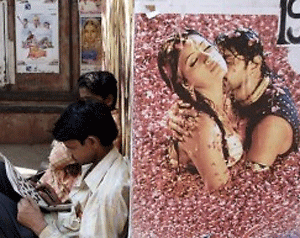
Getting directors, producers and activists into a room to figure out Indian cinema’s connection to violence toward women, rape and crudeness in society can be like a family gathering. People shout, get angry and fail to solve fundamental problems because they can’t agree on anything.
The Siri Fort auditorium in New Delhi recently presented the latest forum for the debate. India’s Ministry of Information and Broadcasting held a six-day festival there to celebrate 100 years of moviemaking, and there was little agreement on how much responsibility Bollywood and the film industry bear for the poor attitude toward women that many people evince. It was perhaps a more pressing discussion than usual, given the name of the three-day workshop, “Cut-Uncut,” which dealt with official censorship in India, the role of sex and violence in movies and the influence of films on society.
To be fair, it’s a question with no apparent answers. Indian films are wildly popular. Storylines and songs become part of the thread of everyday life in a way that’s different than nearly everywhere else in the world. They also reflect a strange prudishness when it comes to love scenes with dance numbers as a substitute – strange because the dance numbers can seem infinitely more erotic than any kiss on the lips or lovemaking scene that they’re supposed to be representing.
Then there is the premise, debated for years in the United States by the music and movie worlds, that these images and the attitudes behind them in cinema reinforce a mindset toward women that brought us horrific stories in the past several months such as the Delhi gang rape and the rape of a Swiss tourist in Madhya Pradesh. Verdict? No answer.
“You want to tell me that rapes are happening in the society because of item numbers? Are you kidding me?” said Luv Ranjan, the director of “Pyaar ka Punchnama” (2011), speaking on day two of the workshop. “Helen was doing item numbers 40 years back. No one was talking about it then.”
Men sit beside posters of Indian films in Mumbai in this picture taken March 21, 2006. REUTERS/Adeel Halim/Files Ranjan’s comment highlighted one of the common themes: you cannot connect “item numbers” featuring lightly clad women dancing provocatively and singing saucy lyrics to an impulse to rape or to take sexual advantage of women perceived as “loose.” To censor art as a result is to destroy artistic freedom and vision.
Another argument: women do not need to be treated as property or hidden away lest men lose their control to their lustful passions.
“Stop your men. Don’t just cover your women. There’s a bigger problem with the mentality of the men in this country,” said Ekta Kapoor, who co-produced “The Dirty Picture” (2011), speaking on day two. The controversial National Award winning film about the late, legendary softcore pornography actress Silk Smitha, took 59 cuts before the censor board allowed it to show on Indian television.
K. Hariharan, a National Award winning director, said on the first day of the workshop that cinema is not a source of decadence. “Cinema informs. It doesn’t tell you to do this or that. Are we teaching you how to be criminals? Come on! Nobody watches movies for a manual on how to do things.”
On the other side, there was Nirmala Samant Prabhavalkar, member of the National Commission for Women, arguing that cinema is a well spring of mass teaching through pop entertainment. Note the figures: Indians spent $1.7 billion in 2011 to buy 2.7 billion movie tickets, the highest number of tickets bought in the world, according to Focus 2012, a report on world film market trends.
Her example, cited at the discussion: the “Fevicol” song featuring actress Kareena Kapoor in the film “Dabangg 2,” which has roughly 8 million views on YouTube. The song features its fair share of shimmying, not to mention lyrics where the woman is described as “salty butter” and “chicken leg piece”. “Women are subjected to acid attack, murder and gang-rape,” Prabhavalkar said on day two. “There’s a definite thread which is linking to these songs?”
The Central Board of Film Certification, which invited Hariharan, wants filmmakers to restrain themselves and parents to teach their children about right and wrong. “No matter how much reality you show in films, it’s still difficult for people to accept it,” said Deepmala Mohun, formerly of the certification board, who spoke on day one’s session on gratuitous violence in films.
(Any opinions expressed here are those of the author and not necessarily of Reuters)